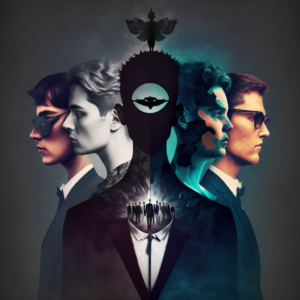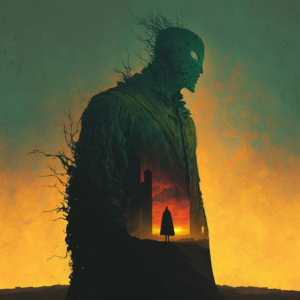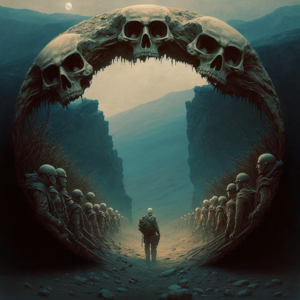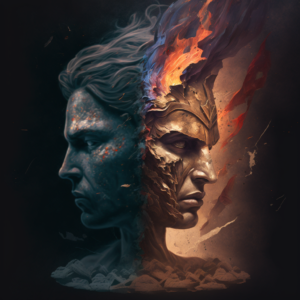Everything seems to have an archetype doesn’t it? Indulge me here and think of a father archetype, now a guard dog, now a shopping trolley, now a 1940s pin-up lady, now an English garden. There’s quite a lot there and to me, it seems like we’re doing that thing that great Swiss thinker, no, not that one, his buddy, Jean Gebser warned us about. Are we guilty of over-labelling things in our day and age? Maybe it’s something humans have always done but I’ve a sneaking suspicion that it’s gotten more problematic over the last 100 years or thereabouts. And maybe we could do with simplifying our lives a wee bit.
The Swiss, a Great Bunch of Lads
Most of us know that it was that mighty man of Switzerland, a country that has, in all fairness produced many mighty men, including Paracelsus and my personal favourite Xherdan Shaqiri, I’m getting distracted here, apologies, yes, Carl Jung, it was Mr Jung who in 1919 wrote a paper called Instinct and the Unconscious. He wrote in it that there is good reason for supposing that “the archetypes are the unconscious images of the instincts themselves, in other words they are patterns of instinctual behaviour”.
He came up with four archetypes, just four; the persona, the shadow, the anima/animus and the self. That’s it, just four. Now, he didn’t invent the term. It first appeared in English in the 1500s and came from a latinized version of a Greek adjective, ἀρχέτυπος, meaning first-molded. But this ἀρχέτυπος word is a compound and it means model, type and/or pattern and is used for the origin points of said models/types or patterns. We know too of Plato’s forms, the old example being to think of a chair. Every chair is different but in your mind you can picture what it is that gives a chair its chair-i-ness, or chair-like qualities. Plato might have been borrowing/pilfering/modifying from our auld mucker Parmenides and his Forms, something I used in a recent bit of fiction writing.
 Carl Jung’s Archetypes
Carl Jung’s Archetypes
So, history lesson over, we all know what archetypes are, don’t we? Let’s run through Carl Jung’s very quickly just in case you need a refresher: The Persona – the idealized self. The Shadow – the unconscious part of ourselves or personality that does not align with our own ideal version of ourselves i.e. the bits we don’t like/accept about ourselves, The Anima/Animus – the unconscious elements of the opposite sex within ourselves and The Self – the unification of consciousness and unconsciousness in ourselves, and representing the psyche as a whole.
Does it seem to you then that the over-proliferation of the archetypes we see now is a bit of a mistake? In applying the archetypes to all types of things now, are we even thinking of archetypes anymore? In over-compartmentalizing things, which is what we do, aren’t we actually talking about stereotypes when we’re supposed to be talking about archetypes?
Let’s go back now to the opening paragraph and let’s examine our archetypes; the father, a guard dog, a shopping trolley, a 1940s pin-up lady, an English garden. What did you think of for each? Now ask yourself this question; were they archetypes you thought of or were they actually stereotypes? The difference isn’t small and I’ve come to think that when we think of archetypes what we’re actually thinking and talking about are stereotypes.
The Branding of Archetypes
To show you how the idea of archetypes has gotten a little out of hand, while researching for this article I came across the 36 Brand Archetypes Yes, you read that properly and no I won’t link to them but as you can guess it’s all about how to use the supposed characteristics of supposed archetypes to ‘position your product in the market’.
It gives examples such as Harley Davidson and the Outlaw archetype, Disney and the Magician, Adidas and the Hero, UNICEF and the Caregiver. Pretty inoffensive stuff in the grand scheme of things but nonetheless not exactly what Carl Jung could have envisaged when he first put pen to empty pages writing that 1919 paper.
There are also many, many products online that exploit the idea of archetypes and I can only guess, or suppose that their popularity is really down to the way we all think. We love to classify things and compartmentalize them into neat little pigeon holes where all things belong but in over-dividing things don’t they lose their power, their identity and their potency? If you take a wheel of Swiss cheese for your raclette, which is annoyingly called raclette cheese, and keep dividing it down by half you’re going to have a pretty dull raclette party if you don’t at least stop after the first cut. You see what I’m getting at.
There was a contemporary of Jung’s, mentioned above, Jean Gebser, born in German-held Posen in 1905, properly called Poznan as it’s a Polish city, the Germans just had a lend of it when Poland temporarily, well, forcibly, retired from being a country from the late 1770s until the end of World War I. Gebser was a really interesting chap with some really interesting ideas on consciousness. Basically, consciousness evolves, and for each evolution the currant form is replaced by a newer form that integrates the former one and ‘improves’ upon it. For this article however, it was Gebser’s ideas of the final phase, the integral phase, that applies. Yes, Ken Wilbur was very much, ahem, inspired by Gebser.
Jean Gebser’s Integral Structure of Consciousness
Bear with me here, I’ll try and make this as uncomplicated as I can. His final phase was called ‘the integral structure’ and it came about when people began to think in terms of time and space. Previously, people had thought of time as having definite features regarding the past, the present and the future.
Now, however, we think that there is one definite structure called time, well spacetime actually but anyway, the idea is that the past, present and future are just parts of that, rather than being ‘whole’ parts in and of themselves.
It can be said then, that actually our awareness points at being ‘integral’ as “That various beings in the present are crystallized from the past, and which also extend into the future. In fact, without already having an integral awareness, one could have no notion of time as “past” or “present”.
The problem with this lies in the fact that we do not really think in this way, be it about time or just in general. We can and occasionally do but for the most part we fragment what we think about and we put things into the appropriate niche we think that it belongs to. For Gebser, the answer was to think in more transcendent terms. Indeed Gebser towards the end of his life lamented where humanity was going as we continued to factor into smaller and smaller niche groups putting further distance between ourselves rather than seeing humanity, and existence even, as one thing.
We all have Two Brains
What got me thinking about the archetypes started with Bernardo’s Kastrup‘s book More Than Allegory where he argues that the societal myths we have actually emerged from our inner consciousness/collective unconscious thanks to the fact that we need to give ourselves mini myths to explain our actions. I spoke about this on a recent TaSTA episode and the idea is that basically we often carry out an activity without actually choosing to do it and then our mind quickly thinks of an excuse as to why we did it and so this reason comes to our thoughts and we believe it.
Now, I understand that might sound cuckoo bananas to most people but it was proven back in the 1960s thanks to doctors splitting brains for the treatment of epilepsy. Here’s a video:
And if you really want to go further into the subject, fall down the Iain McGilchrist rabbit hole of the left-brain, right-brain thing he’s got going on. So this was my starting point, we tell ourselves our own personal myths so we can make sense of both our actions and the actions of people around us and the world at large. We can see though, thanks to these theories, that many of these actions are instinctual rather than well-thought-out. So that bears the questions, are we victims of circumstance or the heroes/creators of our destiny?
The Hero’s Journey and the Seven Basic Plots
This lead me to explore the ideas of the stories we tell ourselves a bit further. How many types of stories are there really? We have the Hero’s Journey of course and I’m a big fan of Joseph Campbell but in 2004 Christopher Brooker released the product of his 34 years of research on stories and said there are just Seven Basic Plots, but all of them can actually fit into a Hero’s Journey. Indeed, not too long after reading Brooker’s book, John Gardner, the literary critic claimed there are, in fact, no more than two plots, “a person goes on a journey” and “a stranger comes to town”. When you think about it, they’re just the Yin and Yang to each other, aren’t they?
 Let’s look at those; a person goes on a journey…wouldn’t you say he’s a hero then? He takes on a challenge and goes for it, he certainly is a hero to himself at the very least. Although he might be running away from something and actually be a victim. Is Frodo a victim because he has to bring the ring to Rivendell and later Mordor? Or the hero for taking on the challenge?
Let’s look at those; a person goes on a journey…wouldn’t you say he’s a hero then? He takes on a challenge and goes for it, he certainly is a hero to himself at the very least. Although he might be running away from something and actually be a victim. Is Frodo a victim because he has to bring the ring to Rivendell and later Mordor? Or the hero for taking on the challenge?
The second one; a stranger comes to town, a victim of some unseen circumstance must leave his place of birth and look for a new place to rest his weary head. Surely he’s a victim? Or maybe he’s done something heroic in his leaving? Maybe these are the actual archetypes we need to be looking at?
Now, on the aforementioned TaSTA episode my thoughts weren’t totally clear, indeed that’s why I write these articles to try and get my thoughts on a subject together but it’s something I’ve been playing around with in my head for quite a while now. What if everything in our lives, i.e. the roles we play, the dramas we become embroiled in, the quests and adventures and callings we undertake can be seen through a magnifying lens, one side shows the hero, the other shows the victim.
Cultural Shadows
And there was the second element why I was thinking in this way and that is to do with what are called ‘cultural shadows’ or ‘pendulums’. A cultural shadow is basically an idea that a culture or a part of a culture/society has bought into. For example; patriarchy, racism, male/female circumcision, globalization, communism, democracy, etc. etc. etc.
These are ideas or concepts that we think are real whereas really they’re just ideas that we go along with. They are illusions, or delusions, and they mask the actual reality of life. Even the idea of ‘the western world’ is a cultural shadow. Many of us seem to have bought into the idea that it’s the ‘shadows’ in ‘the west’ that are bringing down ‘the west’ all the while being completely oblivious to the fact that the whole idea that there’s ‘a western world’ rather than an entire humanity is outlandishly ludicrous.
The idea of what ‘the west’ is has ended at least four or five times I can think of offhand; the end of the Greek world, the end of the Roman Empire, the beginning of the Renaissance, the Protestant Reformation and the resulting religious wars, the French Revolution and the reintroduction of the republic. There you have five times that Western culture/society has fallen and began again. I left out the Black Death, so six.
As Philip K. Dick used to write, the Empire never ended. I could probably think of more times but this article is long enough as it is. I ask you then please to not fall for the fear mongering and nonsense pedaled by people trying to sell you the answers to the ills of society. They don’t have the answers, they just have books to sell and bums to put on seats in venues.
The Hero/Victim Archetypes
This all lead me to play with the idea that there might just be two archetypes; the hero and the victim. If ‘the west is falling and we’re doomed’ then aren’t we the victim? Or maybe because we can see it falling apart and can prepare we’re the heroes, or, at least, we’re going to be them? But hold on, we can actually apply this way of thinking to everyday occurrences.
For example, the wife gives out to you because you forgot to put out the thrash. You feel hurt because it’s the first time in three years you’ve forgotten and you feel she’s being overly harsh. What role are you playing; the victim. But, wait, you answer her back and say; yea, well missy, I’ve been working from dawn till dusk, I was fixing the drains in the morning like you asked me to and then I made the new birdhouse the kids asked for and then I cooked dinner and prepared the kids’ lunches for school. Ah-ha, I’ve put her in her place you think to yourself, now you’re playing the hero, albeit, a bit of a dick-ish hero, you’re being Cyclops from X-Men and nobody likes that guy. 
Another example; you tell your buddy about a girl you like and want to ask her out on a date. But you notice you’re coming up with excuses not to ask her out, she might say no, you don’t have much money to take her until you’re paid, etc. You’re playing the role of the victim again. Or you say things like, I would ask her out but…. this has a tinge of the hero as you’re giving yourself excuses but really it’s the victim showing up again. The hero would just ask her out and if she says yes he wins the day, if she says no, you better believe the victim is going to come back again.
One final one, we all know the Aesop Fable about the fox and the grapes. He jumps and jumps and jumps all day to try and grab the grapes, he doesn’t reach them in the end and he says, ah sure, look, I didn’t want them anyway. Now, you see what he’s doing here? He’s playing the hero to himself because he’s giving himself an excuse why he didn’t want the grapes but we all know it’s the victim who’s really speaking because he’s trying to excuse why he wasn’t able to get the grapes. Actually, I’m the hero, I don’t want them, no mate, you’re pulling the wool over your own eyes and giving yourself a lame excuse because you can’t face the truth.
A Final Question
I asked this above already; are we the victims of circumstance or the heroes/creators of our own destiny? This is an age-old problem in spirituality. Are we just passive witnesses to our fate or do we create our world? We can see both archetypes hard at work here and I don’t think I need to spell it out for you. I’d ask you now to indulge me once again like in the opening paragraph.
A couple of times over the next few days try and see where and when you’re playing either the role of the victim or the hero. Don’t look at the actions of others, just your own and see what happens. From some of the people I’ve been talking to about this idea since the podcast aired they’ve had some realisations about how they’ve been behaving. Now, it’s obviously not as easy as just trying to be the hero all the time, if you do that you’ll turn into an arrogant so-and-so, that’s not what this is about, it’s rather about seeing the roles we play in life and the stories we tell ourselves to explain our behaviour.